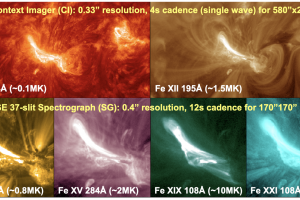La NASA approva la missione MUSE per lo studio della corona solare

Sono ancora numerosi i segreti della corona solare che gli astronomi stanno cercando di decifrare. La corona è l’atmosfera più esterna del Sole, formata da plasma poco denso a temperature elevate, fino ad alcuni milioni di gradi (per confronto, la temperatura del plasma in fotosfera e cromosfera è di circa 5600 e 10000 gradi, rispettivamente). L’energia necessaria per riscaldare il gas fino a queste temperature sembra venga spesso fornita dal campo magnetico del Sole, attraverso fenomeni che avvengono su piccole scale spaziali, denominati “eventi di riconnessione magnetica”, conseguenza dell’evoluzione della topologia locale delle linee di campo magnetico. Non è un caso, quindi, che sia i fenomeni più energetici, come i brillamenti solari, che il plasma a temperature più elevate, vengano osservati in corrispondenza di regioni caratterizzate da un campo magnetico intenso e variabile, denominate “regioni attive”.
Tra le conseguenze dell’attività magnetica del Sole vi sono anche altri fenomeni che possono avere un impatto importante sulla Terra, come il vento solare e le espulsioni di massa coronali. Questi fenomeni, infatti, contribuiscono all’espulsione nello spazio interplanetario di flussi importanti di particelle cariche. Queste particelle, raggiunte la Terra, sono sia causa di fenomeni innocui e spettacolari, come le aurore boreali, che di fenomeni potenzialmente pericolosi, come le tempeste magnetiche. Lo studio di questi fenomeni è così importante che da diversi decenni si è sviluppata una branca specifica della fisica, chiamata “climatologia spaziale”
Per studiare nel dettaglio i processi fisici coinvolti nell’attività coronale del Sole, è necessario uno strumento capace di fornire osservazioni spettroscopiche su un ampio range di scale spaziali, che vanno dalle dimensioni tipiche su cui avvengono i fenomeni di rilascio di energia (≤ 0.5”), a quelle delle regioni attive (>100”), campionando la variabilità di questi fenomeni molto rapidamente (in tempiscala dell’ordine dei 20 secondi). Questo è il concetto della nuova missione MUlti-slit Solar Explorer (MUSE), recentemente approvata dalla NASA come missione di tipo “Medium-class Explorer”, con un budget di 192 milioni di dollari. MUSE sarà equipaggiato con uno spettrografo ed una camera. L’innovativo spettrografo (MUSE 37-slit Spectrograph) che opererà in 3 bande nell’ultravioletto, scelte per poter osservare emissione da atomi di ferro altamente ionizzati, tipica delle regioni attive nella corona solare, e sarà dotato di 37 fenditure che raccoglieranno gli spettri simultaneamente. La camera (MUSE Context Imager) fornirà immagini con una cadenza di 4 sec ed una risoluzione di 0.33″ su di un campo di vista di 580″×290″. Le osservazioni di MUSE permetteranno di raggiungere una comprensione profonda dell’interazione tra il plasma a milioni di gradi ed i campi magnetici intensi e rapidamente variabili su piccole scale che caratterizzano la corona solare, un laboratorio unico nell’Universo per questo tipo di studi. La missione è guidata da B. De Pontieu, del Lockheed Martin Advanced Technology Center di Palo Alto, California, e tra i collaboratori figurano anche F. Reale e P. Pagano dell’Università degli Studi di Palermo, associati all’Istituto Nazionale di Astrofisica, ed A. Petralia dell’INAF – Osservatorio Astronomico di Palermo. MUSE è descritto nell’articolo: “Probing the physics of the solar atmosphere with the Multi-slit Solar Explorer (MUSE): I. Coronal Heating“, pubblicato dalla rivista The Astrophysical Journal.
“Contrariamente a molte missioni che tendono a essere “generaliste”, questa è invece ritagliata per rispondere a pochissime domande ma cruciali.“, dice il prof. Reale dell’Università degli Studi di Palermo, “Insomma osservare poche righe spettrali ma ad alte risoluzioni permetterà di andare nel cuore del problema di cosa riscalda la corona e di quale sia l’origine di vari fenomeni, creando delle relazioni causa-effetto che ad oggi mancano. Le righe selezionate, emesse da plasma a temperature diverse, e il particolare sistema a griglia delle fenditure permetteranno un monitoraggio dei processi fisici che fanno transitare il plasma da basse ad alte temperature, dando così una spallata decisiva alle questioni. La complessità dei fenomeni richiederà più che mai il supporto di modelli sofisticati con l’uso di supercalcolatori, cui contribuiranno i ricercatori di Palermo.”
La figura (cliccare qui per visualizzare l’immagine interamente) mostra un’illustrazione di come MUSE osserverà i dettagli di una regione attiva. I pannelli riportano la cadenza temporale delle osservazioni, il campo di vista, il tipo di emissione osservata e la temperatura del plasma corrispondente.
Mario Giuseppe Guarcello ( segui mguarce) ( youtube)
Segui la pagina Facebook dell’Osservatorio Astronomico di Palermo
Iscriviti al canale Youtube dell’Osservatorio Astronomico di Palermo
